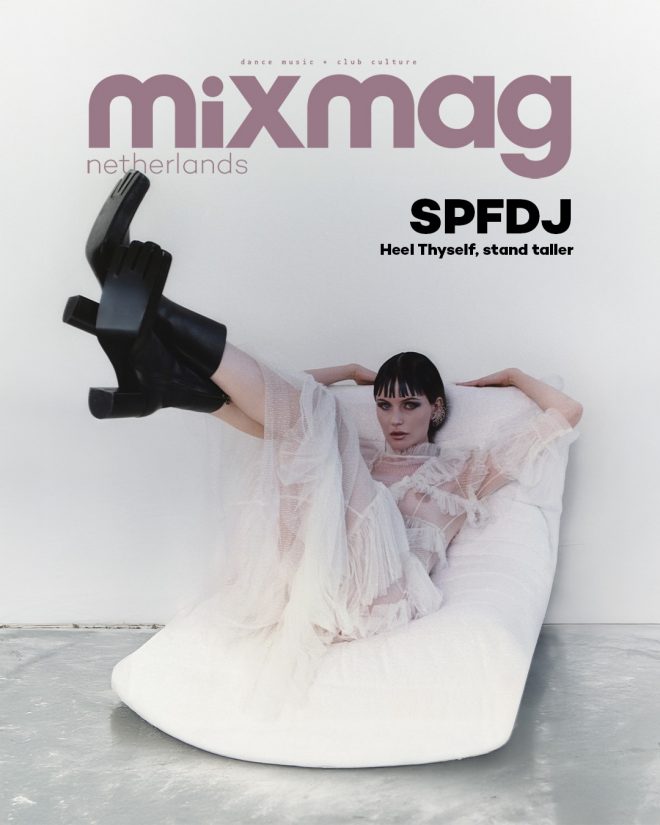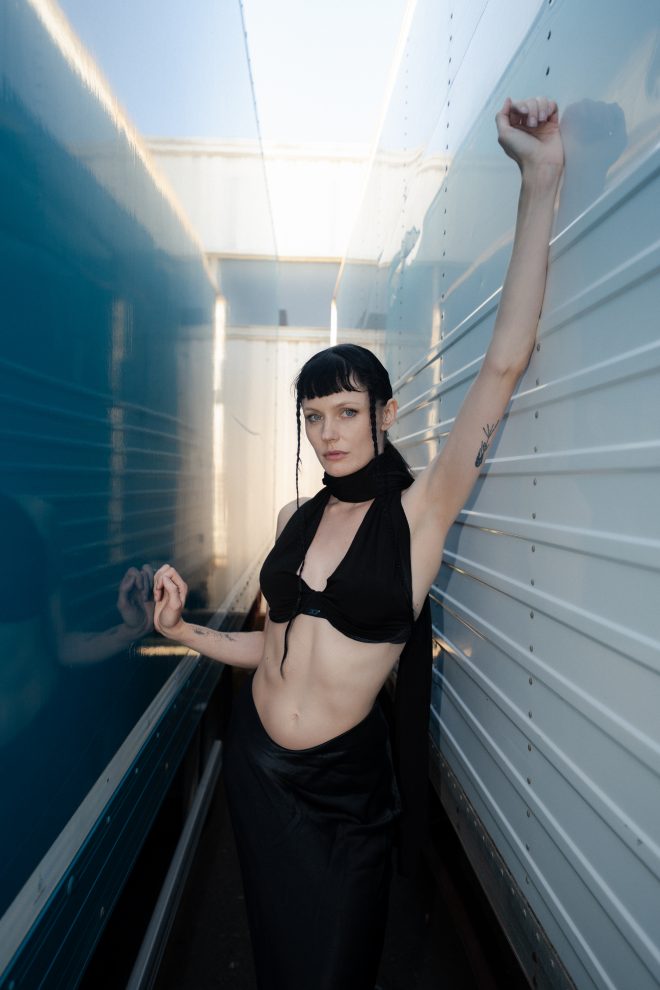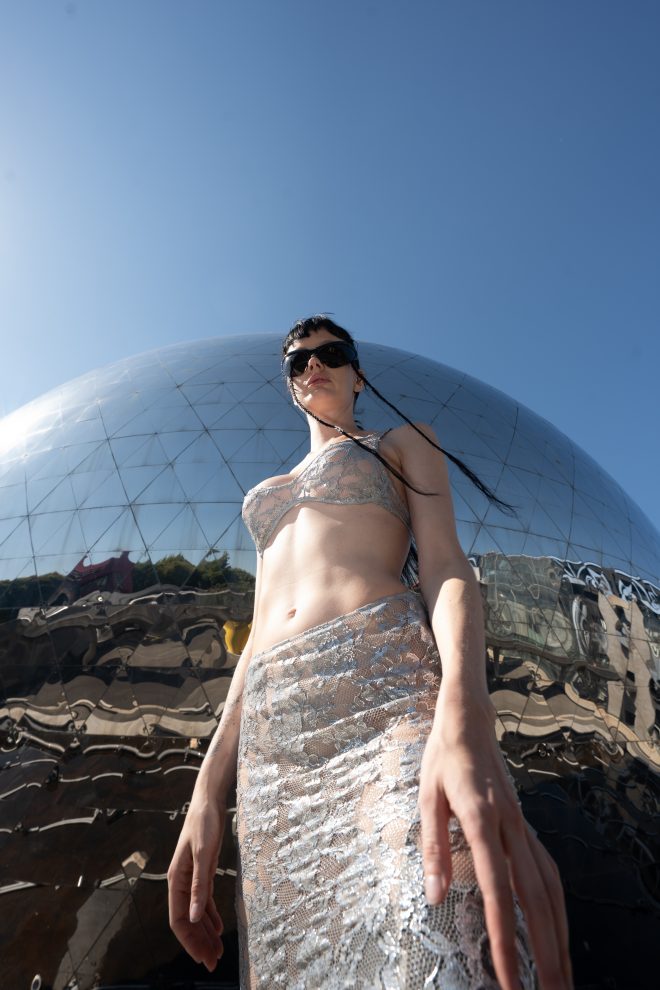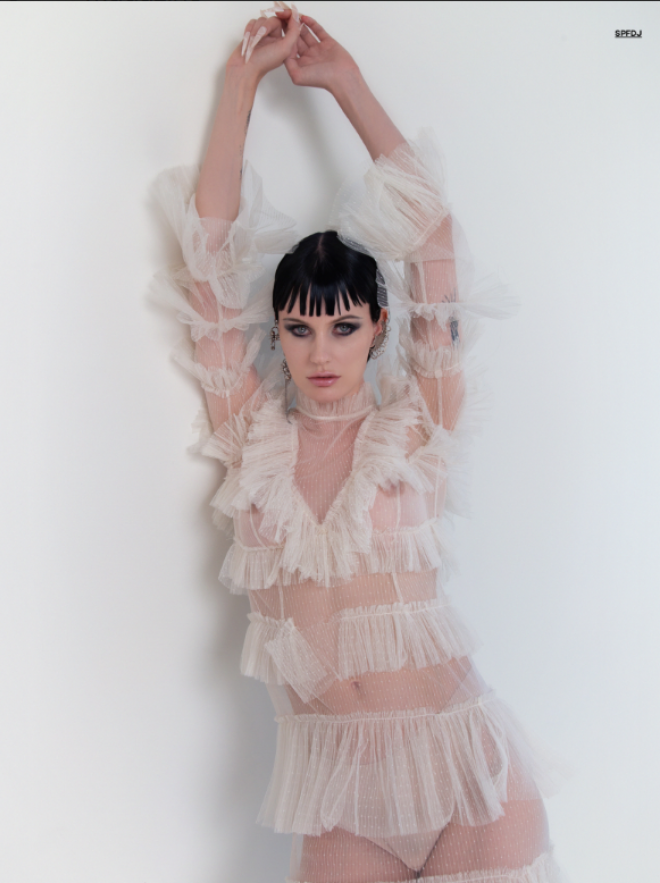SPFDJ | NL 2025 #04
SPFDJ: Heel Thyself, stand taller

SPFDJ has never been content to sit safely at the center. From formative years inside Berlin’s unruliest booths to a sharpened curatorial voice that now echoes across Europe, she has built a practice where toughness and tenderness coexist. The result is a signature electricity that pulls hard toward the floor while leaving room for feeling to breathe.
Her debut EP, Heel Thyself, crystallizes that arc. It is the sound of an artist turning the lens inward, dismantling old habits, building sturdier ones, and using the studio as a place to practice clarity. The title alone hints at the project’s double intention: to mend and to stand tall.
Across radio, DIY parties, and the Intrepid Skin imprint, she has championed uncompromising energy without mistaking intensity for uniformity. Motherlode, her event series, extends that ethos into the room, where she arranges lineups like narratives and insists on surprise as a form of care.
Now rooted in Amsterdam after chapters in London and Berlin, SPFDJ is working with a steadier pulse. The pace has changed, the ambition has not. What follows opens the door on the headspace behind Heel Thyself, the philosophy she calls Tendercore, and the communal architecture she is building for 2026.
Healing, Heels, and the Birth of Tendercore
The headspace behind Heel Thyself is not a straight line. It bends through overthinking, sobriety, and the discipline of resetting. The music found shape when she learned to watch the storm without stepping into it.
“I used to quiet my overthinking by getting a bit wasted, to be honest. In the beginning, I struggled to make music sober. I’d start a track and spiral into ‘now it’s too ravey, now it’s too trancey, now it’s too hard,’ until I’d overthink it to death and discard it. There came a point where I had to face the fact that it wasn’t sustainable, though. I was already in therapy, meditating, reading, listening to podcasts, trying everything to find a healthier way to get out of my head.”
“By late 2023, I’d made enough progress to finish ‘The Hot in Psychotic.’ I was rewatching Gossip Girl at the time, and I think some of that dramatic, mischievous energy slipped into the track. Channelling an external energy gave me the distance I needed to follow the flow. The track now has that sense that something scandalous is happening, but everyone’s secretly enjoying it, and I love that.”
“Not long after, I had what felt like a massive breakthrough. Through meditation and a lot of self-work, I began learning to observe my thoughts rather than identify with them. Once I found that headspace, the music just started to flow. I churned out Fck-boi on a flight to Australia and even experienced what’s sometimes called spontaneous love-attacks, so not only was I productive but blissful too.”
“It wasn’t a linear process, though. Old thought patterns still creep in, but now I know how to reset. I notice a huge difference on days I take time to meditate first. First step for me is always to get my mindset in order, then and only then can I actually create.”
That dual message of mending and defiance extends to the title, where stiletto imagery serves as a banner of self-possession.
“The wordplay happened pretty naturally. I already knew I wanted ‘That Stiletto Track’ to be a central part of the record, so the stiletto imagery was at the front of my mind. At the same time, the whole process of making the EP had been about healing, so when Heel Thyself came to me, it just fit. It connected the emotional side of what I was going through with the aesthetic that was already there. It then also tied it together with that fire in me to push back against misogyny and reclaim power through femininity.”
“For me, heels are a symbol of power. I know for some people they represent something oppressive, like women being expected to wear uncomfortable shoes, but I’ve reclaimed that for myself. I feel powerful when I go all in on my femininity: heels, long nails, long hair, the full thing. There’s strength in owning it fully; it becomes its own kind of armour.”
“Femininity is often seen as soft or weak, but when I go all in like this, I feel the opposite: defiant and strong, but still with my soft and nurturing side underneath it all. Like some badass, caring, motherly supervillain. That duality is fantastic.”
“That same energy carries into the cover art. It’s a high, glittery stripper heel lying on its side, half-submerged in muddy water, still glamorous, still defiant, still giving hardcore dominatrix energy even covered by dirt. It might be half-subdued, but it still radiates power. That contradiction of beauty, strength, and struggle coexisting sums up the spirit of Heel Thyself for me. It’s a cheeky kind of resilience: soft but unbreakable. The title itself feels like a commandment: ‘put your heels on and face the world head-on’, but it’s also a reminder that your real armour starts in your head. Take care of your mindset first, then you can tackle the external.”
Tendercore, her philosophy of toughness and tenderness, is not a brand tag. It is a permission slip to let emotion show up in the mix without apology.
“I’m still very much in the transition phase of bringing that vulnerability in. During my healing and production journey, I kept finding myself drawn to melancholic or somewhat cheesy melodies, but I’d always discard them as ‘too soft’ or ‘too cringe.’ Eventually, I had to ask myself why. Why was I rejecting things that came naturally?”
“I realised I’d been doing the same in my DJing: subconsciously avoiding tracks that felt too emotional because they felt a bit cringe. That’s such a common message in the world: that being emotional means being weak. I’ve always been a highly emotional person, and for most of my life, I saw that as a flaw. Now I’m learning to see it as a strength, even a kind of superpower.”
“Being vulnerable in DJing, for me, means showing all that I feel through my track selection and not just the hard, badass parts, the tender ones too. It’s hard to say whether people are responding to a difference in the sound or to me stepping into the booth with new energy. While being more honest is a bit daunting, it has also brought a new level of confidence and joy behind the decks. I think people can feel that.”

Building Worlds: Intrepid Skin and Motherlode
Curation has been the through line, long before the label. As her platform grew, so did her responsibility to maintain momentum and to let other voices shape her vision.
“I’ve always been a curator at heart. Even before Intrepid Skin, I was running radio shows and DIY parties, inviting guests and booking artists. Back then, I had to think strategically; pairing smaller artists I wanted to spotlight with one bigger guest who could draw listeners in. Now I’m in a position where I can be that bigger artist myself, which means I can use my platform to champion emerging voices directly, which is cool.”
“Running Intrepid Skin has also taught me to balance my perfectionism with momentum. I started completely DIY, doing everything from the artwork to the admin, but with scale, you have to delegate. That’s been one of the hardest and most important lessons, letting go of control in favour of things actually happening. When I brought in Mauro (DJ Saliva) to handle the visual direction, for example, the record sleeves suddenly felt so much more refined while keeping their original raw energy. Letting others interpret your ideas can actually make them stronger.”
“Another big shift came once I started producing seriously myself. Before that, my feedback to artists’ demos came purely from a DJ’s perspective, on how something would hit the dance floor. Now I can also speak from experience in the studio. I’m not a technical expert, but I can still offer guidance or spark ideas that hopefully help artists unlock something. I always try to give feedback that helps them lean into their own identity while also experimenting.”
“Balancing curation with artistic freedom depends on the context. When you’re curating a night, freedom is shaped by time slots; you can’t avoid that! But I try to offset it by inviting the same artist to play at different times across multiple parties so that they can show other sides of themselves. With the label, there’s much more room. An EP can have range, like a couple of peak-time tracks alongside something weirder or slower, or a mix of emotions or styles that remains coherent. I try to encourage that breadth. I want artists to send me the weird stuff too, not just what they think will fit the label. I believe that’s the best route to finding their distinctive sound and that’s what I want to hear.”
Authenticity, for her, has nothing to do with the room size and everything to do with the pulse of the idea.
“I’m not interested in conformity; I want personality. I want to hear someone’s punk attitude be as punk as possible, hear their humour, or their raw emotion. A lot of labels turn into style factories where producers mould themselves to fit a formula. With Intrepid Skin, I try to do the opposite. It’s still my world, obviously, there has to be a common thread, and I’m drawn to sounds I’d actually play, but I want that thread to be as wide as possible. I’m hoping to amplify individuality within a shared energy, not forcing everyone into one sound.”
“Lately, there has been more interest in the kind of sound I play on bigger stages. People tend to assume that moving into larger spaces means selling out, but that’s not how it feels to me. My sound has evolved because my taste has evolved, and I could never play or release music I don’t genuinely love. I physically can’t perform if I’m not excited about the tracks, like I wouldn’t find a flow. Staying authentic to me just means following what excites you, even if that happens to take you to a much bigger room.”
“I think the only real way to stay authentic is to push artists to lean into their own weirdness as much as possible. I don’t care if that ends up reading as underground or commercial, if it’s real, it’s real.”
Motherlode widens the circle, translating that taste into nights that feel intentional from first record to last.
“Motherlode started because I wanted a way to support DJs I really believe in, beyond the limits of my label. When it’s an Intrepid Skin showcase, I can mostly really book people tied to the label, and it’s still a relatively small roster. I wanted a wider umbrella, something that gave me freedom to invite artists whose energy fits what I love, whether or not they’re producers or connected to the label at all.”
“I’m quite a perfectionist when it comes to building a lineup. I don’t just think about which names I want to play, I think about what order they make sense in from the very beginning. If one artist can’t do it, I can’t just substitute someone else in; the whole flow changes, and I usually have to rethink the entire lineup. My agent and the club bookers I work with find it a bit maddening because it makes the logistics harder, but it’s the only way it works for me. It’s actually quite similar to how I build mixes or podcasts at home. If I have to swap out one track, I can’t just drop in a replacement; I have to rebuild that whole section so the progression still flows. When I play in the club or at a festival, it’s all improvised, though, so that’s a different thing.”
“What I want people to feel when they leave is that they heard something they didn’t expect, and that it blew them away. I want them to feel inspired, curious, maybe even a bit shaken in a good way. Like they came for one thing and ended up finding something else they didn’t know they needed.”

New Rhythms, New Realities
Amsterdam has given her a steadier cadence and a clearer center, shifting the frame from pure DJ to artist whose own tracks anchor the narrative.
“Moving to Amsterdam changed my pace completely. Berlin was amazing for the chapter I was in; it gave me freedom and intensity, but it’s also a place where every night can turn into a party. Amsterdam forces a bit more balance. Part of that is cultural, and part of it’s practical; the cost of living here means people can’t go on benders every week. That slower rhythm gave me space to reset and actually process everything I’d been doing for the past few years.”
“It’s also where I started shifting from being purely a DJ into being an artist. DJing, for me, has always been about reading the room: it’s reactive, you’re there in service to the crowd, and you can weave in and out of many different wide sound territories freely. Producing my own music changed that a bit. In my sets, my tracks now feel like anchors; they define the centre of my sound. When I play them in a set, everything else takes on a new context, and suddenly it all feels like part of one coherent world in a different way. That change really came through the healing I went through in Amsterdam. Once I worked through the overthinking and internalised beliefs that were holding me back, I was finally able to step into being an artist more honestly.”
To discuss “the state of techno” in 2025 means confronting not one culture but several, each with its own codes, anxieties, and pressures. She leans into the complexity rather than simplifying it, mapping out a scene that is as fragmented as it is fertile.
“It’s hard to even talk about the ‘state of techno’ now, because the word means completely different things to different people. For some, it’s still the original form; for others, it’s this big umbrella that covers hard techno, hardgroove, bounce, hardbounce, even hard house and latincore. Each of those scenes has its own codes and culture. There’s been a lot of tribalism, like the hard techno people only wanting hard techno and the hardgroove crowd wanting hardgroove, and that kind of mindset often breeds sheep behaviour. It’s safer to follow the crowd than to think for yourself, but that doesn’t push anything forward creatively.”
“I also think that connects to the fear of being called cringe, which feels stronger than ever among younger crowds. Maybe it’s understandable; they grew up under constant observation, where everything ends up online, but it does make people more afraid to experiment.”
“Platforms like TikTok make it even worse. The algorithm rewards familiarity, because people stay to watch things they already recognise: a trending audio or a format they’ve seen before. So creators just repeat what works, because that’s the only way to get visibility. True experimentation barely exists; you have to be creative within the confines of a trend. It’s not individuality that gets rewarded, it’s signalling that you’re part of the herd. And when that mindset seeps into music, you end up with less risk-taking and more imitation.”
“But at the same time, there’s another side to it. Technology has made producing and sharing music more accessible than ever, allowing more people with completely different backgrounds and perspectives to enter the scene. Anyone with curiosity can start producing, and that kind of diversity of perspective always pushes the music forward. I’m cautious about where technology is heading in general, but when it comes to music production, I think it’s a good thing. Used well, it can open up creativity instead of limiting it.”

Stability, Chaos, and What Comes Next
Stability is not the enemy of intensity. It is the foundation that lets it roar on command.
“Early next year will be about building a bit more stability around me so I can give myself the space to create properly. I’ve been in survival mode for a while, juggling too many things alone, and I’m now putting a proper structure in place. I’m expanding my team and looking for the right management to help me grow the projects I’ve already started, like Motherlode and Intrepid Skin, instead of constantly scrambling to keep up with them.”
“With Intrepid Skin, I want to keep growing the label and finding new, unique artists to support. I’m also expanding the formats into new digital releases alongside the vinyl EPs, and I’m currently putting together our first various-artists compilation, which will come out in 2026.”
“With Motherlode, I want to take it further, bring it to more cities and, when the time’s right, start hosting our own stages at festivals. That’s the direction I see it heading in.”
“On a personal level, I want to do some collabs next. I have a few ideas and dreams brewing about who with, but I’m keeping those to myself until they materialise. I also want to create some fun merch items, of which I have exciting ideas, basically physical versions of the attitude that’s in my music. And I’ve been talking with friends about some ideas that mix tech and music, but I’ll keep those to myself for now too.”
“I’ve got way more ideas than hours in the day, but I’m excited to see which ones take form. It’s all a bit chaotic, but that’s just the way I am.”
SPFDJ stands as one of the most compelling figures of her generation precisely because she refuses to simplify herself. Her work moves between catharsis and confrontation, discipline and abandon, healing and hedonism. Heel Thyself doesn’t just introduce her as a producer; it exposes her as a human being in motion, learning to translate chaos into coherence.
What’s striking about her evolution is how she reframes power. For SPFDJ, power isn’t loudness or hardness; it’s presence, the ability to hold space for contradiction and still radiate confidence. The same artist who once defined herself through intensity now uses vulnerability as voltage, transforming the club from a site of escape into one of reclamation.
There’s also a rare honesty in her relationship to the scene itself. She recognizes both its magic and its pitfalls, its freedom and its conformity, and still chooses to shape it with care rather than cynicism. Whether through Intrepid Skin, Motherlode, or the sonic manifesto of Heel Thyself, she’s crafting spaces where individuality thrives and emotion is not only allowed but required.
In the end, SPFDJ’s story is not about ascension but integration. The rave, the healing, the label, the quiet mornings in Amsterdam, they all feed the same rhythm. She’s an artist redefining what resilience sounds like: strong but self-aware, glamorous yet grounded, hard-edged but human. And as she steps into this new chapter, it’s clear her most significant act of defiance is simply to feel, fully and without fear.



